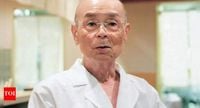On October 27, 2025, Jiro Ono, the legendary sushi master from Tokyo, marked his 100th birthday—a milestone few reach, let alone while still at the top of their field. For most, the century mark signals a time for rest and reflection, a well-earned retirement. Not so for Ono, who has declared, "I plan to keep going for about five more years." According to the Associated Press, Ono remains steadfast in his belief that "the best medicine is to work." Even at 100, he tries to work whenever possible, a philosophy that’s not just kept him busy but, arguably, kept him thriving.
Ono is no ordinary centenarian. Born in 1925 in Hamamatsu, central Japan, he began his apprenticeship at the tender age of seven at a local inn’s restaurant. By 25, he had moved to Tokyo and become a sushi chef, and in 1965, at age 40, he opened Sukiyabashi Jiro—a tiny, 10-seat sushi bar tucked away in the basement of a building in Ginza, one of Tokyo’s most exclusive districts. Over the decades, Sukiyabashi Jiro has become a culinary mecca, celebrated worldwide for its uncompromising standards and meticulous artistry.
His pursuit of perfection is legendary. As Ono said in the 2012 award-winning documentary Jiro Dreams of Sushi, “I haven’t reached perfection yet. I’ll continue to climb trying to reach the top but nobody knows where the top is.” That restless drive has been the backbone of his astonishing career. It’s also what made him the first sushi chef to earn three Michelin stars in 2007, a distinction he held for more than a decade. In 2019, Guinness World Records recognized him as the oldest head chef of a three-Michelin-star restaurant at 93 years and 128 days.
But the accolades only tell part of the story. Ono’s life is a testament to the power of discipline, humility, and purpose. He has served world leaders—including then-U.S. President Barack Obama and Japan’s Prime Minister Shinzo Abe, though not without a touch of characteristic stubbornness. When the Japanese government called to reserve a table for the two dignitaries in 2014, Ono reportedly turned them down because his restaurant was fully booked. Only after they agreed to come later in the evening did he welcome them, and, according to his son Yoshikazu, Obama smiled and winked after sampling the medium fatty tuna sushi.
Ono’s daily habits offer a blueprint for longevity that’s refreshingly simple. He avoids alcohol, eats with intention and moderation, and walks regularly. As reported by AP News, he still goes to work when he can, takes regular walks, eats simply, and steers clear of excess. There’s no mention of rigorous gym routines or fad diets—just a commitment to steady movement and mindful eating. His favorite sushi? "Maguro, kohada and anago (tuna, gizzard shad and saltwater eel)," he told the Associated Press, a nod to the classic ingredients he’s spent a lifetime perfecting.
Longevity experts often highlight the importance of purposeful engagement, and Ono’s life is a case in point. Rather than viewing retirement as the finish line, he sees each day as another opportunity to refine his craft. “Purposeful engagement—having meaningful work or activity—is considered key to improved mental health, sharper cognition, and a longer and healthier life,” notes longevity research echoed in his story. For many, this doesn’t mean staying chained to a job, but rather finding something meaningful that keeps you curious and connected.
Ono’s humility is as striking as his skill. Despite global fame, he is described by those who know him as humble and kind. Director David Gelb, who filmed Jiro Dreams of Sushi, recalled feeling intimidated at first by the sushi master’s gravitas, but was quickly disarmed by Ono’s humor and generosity. Gelb remembered, “I was filming an octopus being massaged for an hour, and he was worried about me. He was afraid I was making the most boring film ever and told me I could leave if I wanted to. He was so generous and kind of humble.”
Ono’s dedication to his regular customers is legendary. Even as his hands have grown less nimble with age, he continues to serve sushi to special guests. In recent years, his restaurant has limited reservations to regulars or those arranged through top hotels, a move that led to its removal from the Michelin Guide in 2020. Yet, the exclusivity only adds to the mystique. For those lucky enough to secure a seat, the experience remains unparalleled.
Family is another cornerstone of Ono’s enduring legacy. His son Yoshikazu has long worked by his side and now serves as head chef at Sukiyabashi Jiro, ensuring the restaurant’s traditions continue. The passing of skills and values from one generation to the next is a cherished aspect of Japanese culture, and in the Ono family, it’s alive and well.
Japan is one of the world’s fastest-aging countries, with nearly 100,000 centenarians, according to government statistics. Ono’s story resonates deeply here, especially as the nation celebrates “Respect for the Aged Day,” a holiday he marked this September with a special gift and certificate from Tokyo’s governor. Watching the news of Japan’s oldest man passing away at 113, Ono reportedly remarked that 13 more years “seems doable.” With a twinkle in his eye, he added, “I will aim for 114.”
What drives a man to keep striving at an age when most have long since retired? For Ono, it’s a blend of discipline, curiosity, and a sense of service. “I cherish my life so I get to work for a long time,” he says. It’s an ethos that’s inspired not just his peers, but people around the globe. As Gelb put it, “It’s an incredible thing that this tradition continues and that he’s still going strong 100 years in ... It’s an inspiration to everyone.”
Ono’s five habits—purposeful work, regular movement, mindful eating, lifelong learning, and cultivating connection and humility—are deceptively simple, yet profoundly effective. As we watch him continue to shape the world of sushi and defy expectations about aging, his story reminds us that a life well-lived isn’t just about reaching a ripe old age. It’s about bringing passion, discipline, and joy to every day, no matter how many candles are on the cake.

